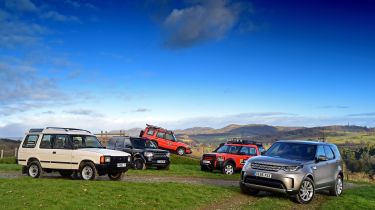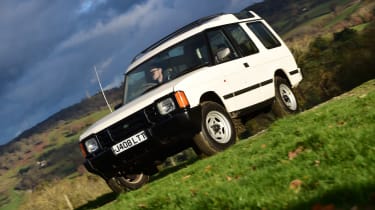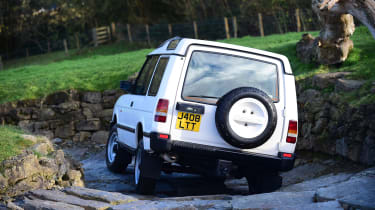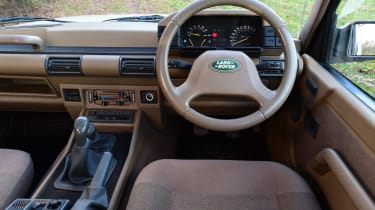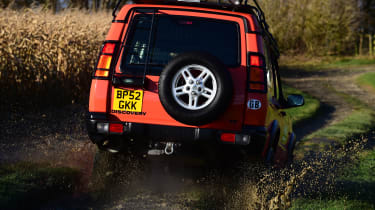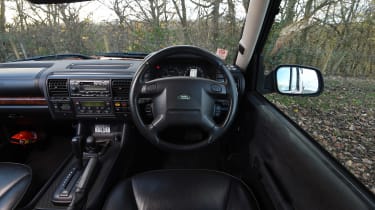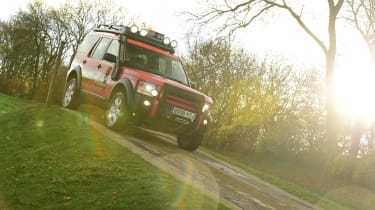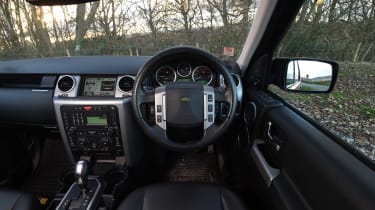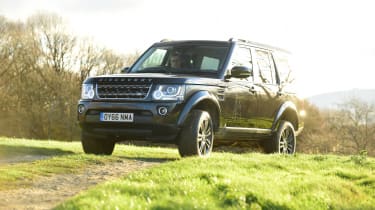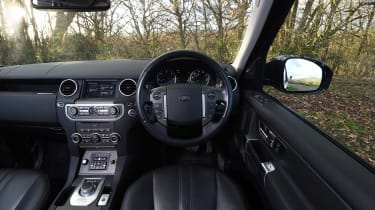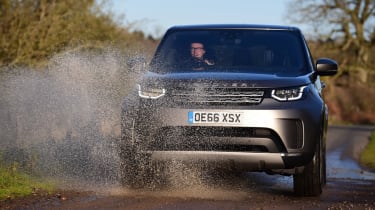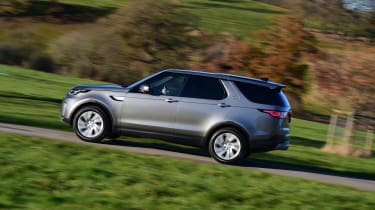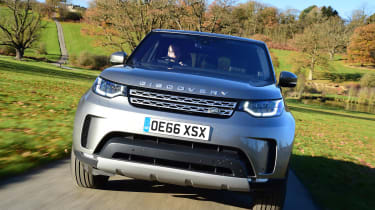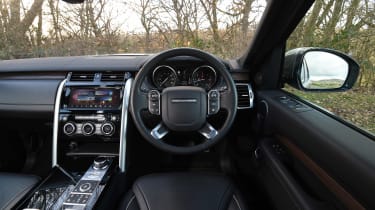New Land Rover Discovery 5 vs 4, 3, 2 and 1: Disco generations review
We assemble five generations of Land Rover Discovery – from three decades – to see how far this off-road legend has come
It was a landmark year for the Land Rover Discovery in 2017. While the nameplate has spanned nearly three decades, there have only been five models, so the launch of the all-new fifth-generation version earlier in the year was a milestone in the Discovery’s timeline.
Another significant moment for the Discovery was when the Mk5 scooped the Car of the Year crown at the Auto Express New Car Awards in 2017. However, there are older and more significant links between Auto Express and the Discovery than you might think. Original prototypes were undergoing final testing in the same year that the first issue of Auto Express was published back in 1988, and it was one of the first cars we carried spy shots of.
For our special Christmas road test, we headed on a trip down memory lane – both on and off-road – as we took the current, fifth-generation Discovery we’re running on our fleet to meet its ancestors, assembling all five generations of this iconic 4x4.
Land Rover Discovery Mk1
| Model tested: | Land Rover Discovery Mk1 200Tdi |
| Engine: | 2.5-litre 4cyl turbodiesel |
| Gearbox: | Five-speed manual, four-wheel drive |
| Power/torque: | 111bhp/265Nm |
| 0-60mph | 17.1 seconds |
| Top speed | 92mph |
SUVs are common today, but 30 years ago, things were different. Land Rover had its iconic, go-anywhere four-wheel-drive workhorse that would go on to become the Defender, while it had proven that luxury and off-road ability could be combined in the opulent Range Rover. But it was looking for a third model to bolster the line-up.
Used - available now

2023 Land Rover
Discovery
25,537 milesAutomaticDiesel3.0L
Cash £43,700
2013 Land Rover
Discovery
89,000 milesAutomaticDiesel3.0L
Cash £16,995
2019 Land Rover
Discovery
59,930 milesAutomaticDiesel3.0L
Cash £27,899
2019 Land Rover
Discovery
75,025 milesAutomaticDiesel3.0L
Cash £32,970Enter the Discovery. The prototype was originally known as Project Jay, and its aim was to adopt parts already used in the Range Rover to produce a more affordable, mass-market car. And so in 1989 the Discovery was launched to the world.
As with the Range Rover, the Discovery was originally only available as a three-door like the one we’ve driven here; a more practical five-door variant was made available a year later.
From the start, the Disco boasted the calling card that’s defined every generation: seven-seat capability. The two rear jump seats were an option to begin with, but when fitted they folded down from the sides of the boot to help fulfil the Discovery project’s brief as a ‘lifestyle vehicle’ – who knew how accurate Land Rover was right from the start? But there was some rugged technology underneath that helped it deliver on that promise and earn its stripes as a proper Land Rover, too.
The choice of engines included a 3.5-litre Rover V8 petrol with a relatively puny 154bhp and a 111bhp 2.5-litre four-cylinder turbodiesel. Both came with a five-speed manual with high and low-range gears, plus a lockable centre differential to help off road. An automatic gearbox was added later to improve refinement, but it didn’t sap any of the Discovery’s rugged appeal.
This early three-door model from Land Rover’s heritage collection is fitted with the 200Tdi diesel. It’s no surprise that it’s not up to the levels of refinement of a modern motor, with an agricultural idle and diesel rattle under load. But as the car isn’t burdened with the same level of safety systems and electronic gadgetry of today’s model, performance is actually acceptable, plus that robust and rugged Land Rover feel is instantly apparent.
The 0-60mph sprint takes 17.1 seconds officially, while there’s a useful level of torque to pull the bulky body along.
However, the Mk1 feels its age when it comes to ride and handling. Its body-on-frame construction isn’t the best dynamically, and combined with slow steering the Disco feels a little lethargic to change direction, although this gives plenty of stability off road. The ride sends a few clonks through the cabin, too, rattling the wonderful period trim. While it looks a little dated now, it was luxurious back in the day.
You have to forgive the passage of time, so while it’s less than sharp on the road, the Mk1 can still surprise off it. With the low-range box, locking centre diff and plenty of ground clearance, it can pretty much go anywhere – no surprise given many of its mechanical parts are shared with the Range Rover. The Discovery’s off-road ability set the template for every generation that followed, and it still leads its rivals when it comes to talent off the tarmac.
Land Rover Discovery Mk2
| Model tested: | Land Rover Discovery Mk2 4.0 V8 |
| Engine: | 4.0-litre V8 petrol |
| Gearbox: | Four-speed auto, four-wheel drive |
| Power/torque: | 182bhp/340Nm |
| 0-60mph | 12.8 seconds |
| Top speed | 106mph |
A decade passed between the launch of the original Discovery and the second-generation model in 1998. But in terms of looks, the Mk2 was more of a refinement of what went before, rather than a clean-sheet design.
Land Rover spruced up the styling so the Discovery could keep pace with newer models launching around the same time, such as the BMW X5 and Mercedes M-Class. But it still had an advantage, thanks to seating for seven.
• Best seven-seats cars available
Every body panel apart from the tailgate was new, while the interior was similarly reworked to give it a classier feel. However, there were plenty of tweaks over the original – 720, according to Land Rover – that meant this second-generation Discovery kept pace with the pack.
Diesel became more popular, so a new 2.5-litre in-line five-cylinder Td5 unit was introduced with 136bhp. Buyers could also still opt for the traditional Rover V8. In 182bhp 4.0-litre form, our Mk2 test car has a delightfully throaty roar under load, with a muted burble when cruising. It’s not fast, but there’s a swell of torque in the mid-range that means the Land Rover makes effortless progress, helped by the four-speed auto that shifts smoothly, if not very quickly.
The Mk2 still kept its no-nonsense off-road talent, thanks to the addition of a few new features. The Discovery Mk2 marked the introduction of hill descent control alongside traction control, with the car’s more advanced electronics computing the best solution to the problem of rough terrain. Air-suspension was also available for the first time, giving the Discovery its trademark refined ride.
With all this tech, the Mk2 really feels like the start of the journey towards today’s luxury SUV. While the infotainment offering didn’t move things on, the quality and comfort were much improved, while the Discovery also felt more modern – especially with this facelifted model we’ve tested here.
The rearmost row of seats were still for occasional use, rather than the plusher third row set-up that would replace it in the Discovery 3, but the traits that have carved out the Discovery’s niche over the years were present and correct. There was lots more tech on offer, including a new Active Cornering Enhancement system that featured an electronically controlled hydraulic anti-roll bar system as on the latest McLaren 720S supercar, which means the Disco is actually more composed in corners than you might think.
Despite the styling not changing much (tweaked headlights like our orange G4 Challenge-spec car kept it looking modern mid-way through the car’s life), this second-generation Discovery still feels mature.
It’s no stretch to see the lineage between the original Discovery and the fifth-generation model, and you can feel the link between this Mk2 and the newer versions.
The making of the modern Disco’s trademark loping ride and general air of sturdiness is apparent. However, by 2004 the Discovery was again starting to feel a little long in the tooth. Cars like the Volvo XC90 had hit the market and were giving the Disco some stout competition. Nearly 20 years had passed since the Discovery project was first floated, and what Land Rover did with the famous nameplate next would wow the world.
Land Rover Discovery Mk3
| Model tested: | Land Rover Discovery 3 TDV6 |
| Engine: | 2.7-litre V6 turbodiesel |
| Gearbox: | Six-speed auto, four-wheel drive |
| Power/torque: | 188bhp/440Nm |
| 0-60mph | 11.7 seconds |
| Top speed | 112mph |
The Discovery 3 was a departure from the norm for the famous nameplate. In 2004 Land Rover wanted to crack America, so its design team went big and bold, with a slabbier, more solid look and square, chiselled proportions.
Retaining some of the car’s visual trademarks, like the little glass panels in the rear of the stepped roof, vertical tail-light blocks and asymmetric rear glass with an offset number plate, the third-generation model is clearly a Discovery, only reimagined for the new millennium.
Underneath, the body is still mounted on a ladder frame chassis, but there’s independent suspension and an even more sophisticated air set-up that improves the Discovery’s ride and refinement even further.
Climbing out of the Mk2 and into this Discovery 3, it’s like moving from black and white to colour the step really is that great. Not one part was carried over from second to third-generation models, and it shows.
Thumb the Discovery’s starter button and the 188bhp 2.7-litre V6 turbodiesel that was new for this model purrs away with a muted but subtly muscular vibe. It’s certainly more subtle than our test car’s bright orange paintwork, winch, extra bodywork protection and huge snorkel to help the engine breathe when you’re wading through a river. That’s because, as the stickers suggest, this Discovery was originally equipped for Land Rover’s G4 Challenge – the follow-on to the Camel Trophy global rally event.
To match the bolder styling the Disco 3 features even more off-road-focused tech, and evolving from later versions of the Mk2, it’s all controlled electronically through Land Rover’s Terrain Response system, with different modes to choose from depending on the surface.
The dials and knobs on the transmission tunnel mean you can tailor the car’s set-up at the touch of a button, and while the V6 doesn’t exactly make this 2.5-tonne-plus SUV fast, 440Nm of torque and the smooth auto box at least mean off-road progress isn’t in doubt.
On the road the Discovery rides beautifully. While that mass means the handling isn’t what you’d call sharp, it does float over rough tarmac with plenty of composure.
It’s helped by the transmission. A six-speed manual was standard, but on the second-hand market these are a rarity because the six-speed auto is much better suited to the car’s character. On top of this, the Disco’s final row of seats is actually usable for more than a short hop.
In comparison with the non-existent infotainment system in the outgoing Mk2, when the Discovery 3 arrived in 2004 the sat-nav unit brought the car into the modern era where in-car technology was concerned, even if the set-up is a little dated by today’s standards.
Land Rover Discovery Mk4
| Model tested: | Land Rover Discovery 4 SDV6 |
| Engine: | 3.0-litre V6 turbodiesel |
| Gearbox: | Eight-speed auto, four-wheel drive |
| Power/torque: | 252bhp/600Nm |
| 0-60mph | 8.8 seconds |
| Top speed | 112mph |
The cracks had started to show five years after the Discovery Mk3’s launch, but a facelifted car in 2009, known as the fourth generation, improved things.
The Mk4’s design changes, including new bumpers, headlights and tail-lamps, gave the model a stronger family resemblance to the Range Rover and Range Rover Sport of the time, plus there were improvements under the skin.
During the car’s life, the V6 turbodiesel engine evolved into a 252bhp 3.0-litre unit. Performance was improved, with the 0-62mph sprint taking 8.8 seconds, while an eight-speed auto and stop/start boosted efficiency, even if claims of 36.7mpg and 213g/km CO2 are optimistic.
On top of this there’s more safety tech for the Mk4 and improved materials inside, which give the Discovery an even more upmarket feel and refined driving experience.
While Land Rover hit its targets when it came to the car’s heightened sense of maturity, the model feels similar dynamically. The same slow steering means you vaguely point the car where you want to go, rather than scything through corners with greater precision like you might in a BMW X5. The Disco Mk4 doesn’t do anything quickly, but it does mean there’s a great deal of comfort on offer.
You waft rather than charge down the road, and even with the all-new Disco Mk5’s technology, the Mk4 still feels thoroughly modern when it comes to performance and refinement. Quality is a step up over the Mk3, too, with an even more refined version of Terrain Response. Soft leather and rugged hardware mix to make this one of the most capable 4x4s of its time, even as a used buy today.
However, by 2016 when the Discovery Mk 4 went out of production, the car’s underpinnings were still capable but not exactly at the cutting edge. It was time to beckon in a new era for Land Rover…
Land Rover Discovery Mk5
| Model tested: | Land Rover Discovery Mk5 Td6 |
| Engine: | 3.0-litre V6 turbodiesel |
| Gearbox: | Eight-speed automatic, four-wheel drive |
| Power/torque: | 254bhp/600Nm |
| 0-60mph | 7.7 seconds |
| Top speed | 130mph |
The Discovery Mk5 made its debut earlier this year, sporting two major new features. The first is a new monocoque chassis that helps reduce the car’s weight by up to 480kg over its predecessor. This is helped by the return of a four-cylinder turbodiesel engine, producing 237bhp; together these boosted the new model’s efficiency, making the Disco a more attractive prospect for many.
But while the 2.0-litre Ingenium diesel offers enough power and respectable refinement for a four-cylinder, the creamy V6 is still the one to go for, carrying just a £1,300 price premium.
The car we’re running on our fleet is fitted with this engine. A healthy 254bhp and 600Nm of torque mean the Disco makes effortless progress, and with a lighter body to control, the air suspension makes easy work of lumps and bumps, riding torn roads with great refinement.
However, the Disco still weighs more than two tonnes, so it’s no mountain goat when it comes to agility, even if the steering is a nice speed and well weighted, too.
Land Rover’s Terrain Response 2 system means it is a mountain goat off the tarmac, though. You’ll know when the 900mm maximum wading depth is reached thanks to sonar tech developed from its predecessors and perfected here, while the system will automatically sense what surface you’re on and adjust the engine, gearbox, suspension and four-wheel drive to suit, so you no longer have to touch a button.
On the challenging trails of the Eastnor Castle estate the Discovery proved imperious, shrugging off the different terrain and obstacles of Land Rover’s off-road experience.
However, despite the Discovery’s disdain for mud, rocks, sand and snow, large SUVs like this are mostly used on the road, and this all-new Disco is simple to live with.
Depending on which spec you go for, the car’s two rear rows of seats can be folded remotely using a smartphone app, or through the new touchscreen infotainment system.
The longer body and wheelbase mean plenty of room inside with more comfort on offer for all seven occupants, while a decent level of boot space – 1,137 litres in five-seat form – ensures you’ll be able to bring plenty of luggage.
Land Rover’s Discovery nameplate has been carved off as a sub-brand in its own right now, so with styling to match the smaller Discovery Sport – which has divided opinion – there are a few more controversial features on this car. Purists might lament the loss of the split tailgate, but with an electrically operated fold-out ledge that can support up to 300kg, there’s no drawback when it comes to functionality.
In fact, the Discovery Mk5 is the embodiment of nearly 30 years of development. The car has come a long way over five generations and offers more comfort, refinement, space, off-road performance and advanced tech than ever.
It’s a cut-price Range Rover that boasts even more usability and is our undisputed seven-seat SUV king.
